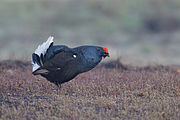How Can We Help?
Lyrurus is a genus of birds in the grouse subfamily. They are known as black grouse because the male's plumage of both species is colored black as its base colour.
Taxonomy
The genus Lyrurus was introduced in 1832 by the English naturalist William John Swainson with the black grouse as the type species.[1] The genus name combines the Ancient Greek lura meaning "lyre" with -ouros meaning "-tailed".[2]
Species
The genus contains two species:[3]
| Common name | Scientific name and subspecies | Range | Size and ecology | IUCN status and estimated population |
|---|---|---|---|---|
| Black grouse | Lyrurus tetrix (Linnaeus, 1758) |
Europe (Swiss-Italian-French Alps specially) from Great Britain (but not Ireland) through Scandinavia and Estonia, eastwards through Russia and parts of Kazakhstan, Mongolia, and China
|
Size: Habitat: Diet: |
LC
|
| Caucasian grouse | Lyrurus mlokosiewiczi (Taczanowski, 1875) |
The Caucasus, specifically the Caucasus Mountains | Size: Habitat: Diet: |
LC
|
References
- ^ Swainson, William John; Richardson, J. (1831). Fauna Boreali-Americana, or, The Zoology of the Northern Parts of British America. Vol. Part 2. The Birds. London: J. Murray. p. 497. The title page bears the year 1831 but the volume was no published until 1832.
- ^ Jobling, James A. (2010). The Helm Dictionary of Scientific Bird Names. London: Christopher Helm. p. 233. ISBN 978-1-4081-2501-4.
- ^ Gill, Frank; Donsker, David; Rasmussen, Pamela, eds. (July 2021). "Pheasants, partridges, francolins". IOC World Bird List Version 11.2. International Ornithologists' Union. Retrieved 23 August 2021.








Recent Comments